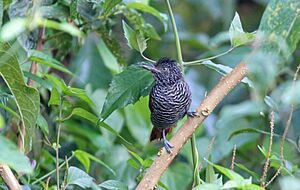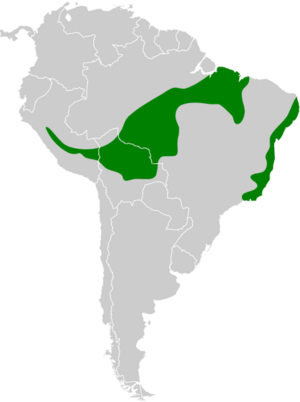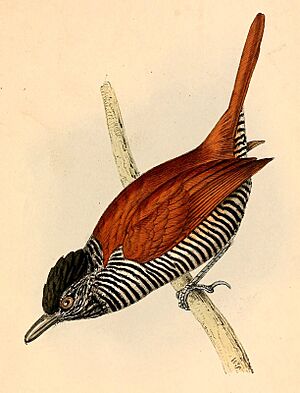Chestnut-backed antshrike facts for kids
Quick facts for kids Chestnut-backed antshrike |
|
|---|---|
 |
|
| male | |
| Conservation status | |
| Scientific classification | |
| Genus: |
Thamnophilus
|
| Species: |
palliatus
|
 |
|
The chestnut-backed antshrike (Thamnophilus palliatus) is a cool bird that lives in parts of Bolivia, Brazil, and Peru. It belongs to a group of birds called "typical antbirds."
Contents
About the Chestnut-backed Antshrike
This bird has a few different types, called subspecies. Think of them like different versions of the same bird, each living in a slightly different area. There are four known subspecies:
- T. p. palliatus
- T. p. vestitus
- T. p. puncticeps
- T. p. similis
Scientists once thought another bird, the lined antshrike, was just a subspecies of the chestnut-backed antshrike. But studies showed they are actually two separate, but very closely related, species.
What Does This Bird Look Like?
The chestnut-backed antshrike is about 16 to 17 centimeters (6 to 7 inches) long. It weighs around 26 to 28 grams (about 1 ounce). Birds in the Thamnophilus group are known for their strong beaks. These beaks have a hook, a bit like those of a shrike bird.
Male and female chestnut-backed antshrikes look a little different, which is called sexual dimorphism. Both sexes have a crest of feathers on their heads.
- Males of the main subspecies (T. p. palliatus) have a black head with white spots on their forehead. Their face and neck are black with white spots. Their back, wings, and tail are a reddish-brown color. Their throat has black and white stripes, and the rest of their belly is striped black and white.
- Females look similar to males. But they have a deep reddish-brown head and wider white stripes on their belly.
Young males look a bit like adult males, but with some reddish-brown on their head. Young females have narrower black stripes and a yellowish color on their lower belly. All adult birds have light-colored eyes, but the exact color can change.
Where Do They Live?
The chestnut-backed antshrike lives in different areas that are not connected.
- One subspecies, T. p. vestitus, lives along the coast of eastern Brazil.
- The most common subspecies, T. p. puncticeps, is found in southeastern Peru, across northern Bolivia, and in Brazil south of the Amazon River.
- The main subspecies, T. p. palliatus, lives in Brazil, also south of the Amazon, stretching to the Atlantic coast.
- Another subspecies, T. p. similis, is found in central Peru.
These birds like to live in places that are somewhat open. This includes the edges of thick forests, older forests that are growing back, and even old farms with lots of bamboo. In some areas, they also live in flooded forests or pure bamboo stands. In coastal Brazil, you might even spot them in shrubby parks and gardens.
They can be found at different heights depending on the area. In the Peruvian Andes, they live between 400 and 1,700 meters (about 1,300 to 5,600 feet) high. In Bolivia, they can be as high as 2,200 meters (about 7,200 feet). In southeastern Brazil, they usually stay below 300 meters (about 1,000 feet) but can go up to 1,000 meters (about 3,300 feet).
How Do They Behave?
Staying in One Place
The chestnut-backed antshrike usually stays in the same area all year round. It doesn't migrate to different places.
What Do They Eat?
We don't know every detail about what they eat. But we know they like to munch on different insects and other small creatures like spiders. They usually look for food alone or in pairs. Sometimes, they join groups of different bird species that are feeding together.
They search for food in thick plants, from close to the ground up to about 15 meters (50 feet) high. They hop between branches and quickly grab prey from leaves, stems, and tree trunks. In eastern Brazil, some have been seen following swarms of army ants, but only in very dense areas.
How Do They Raise Their Young?
The breeding season for the chestnut-backed antshrike isn't fully known. In southeastern Brazil, it's from October to January. In the Amazon, it seems to start in November and might last until June.
Their nest is a small, deep cup. It's loosely made from things like fungus, roots, and other plant fibers. Sometimes, they cover it with green moss. They hang the nest from a branch fork, usually about 1.5 to 3 meters (5 to 10 feet) above the ground in a thick bush. They typically lay two eggs. We don't know how long the eggs take to hatch or how long the young birds stay in the nest.
What Do They Sound Like?
The chestnut-backed antshrike has a special song. It's a series of quick, slightly nasal notes that speed up. The pitch goes up a little at first, then clearly drops towards the end. It finishes with a longer, strong, downward-sloping note. People have described it sounding like kah kah-kah-kah-ka'ka'ka'kaka'pah.
They also have different calls. One is a short, strong, nasal sound, like "awr!. Another call is a long, squealing whistle, like "wheeu."
Is This Bird in Danger?
The IUCN (International Union for Conservation of Nature) says the chestnut-backed antshrike is of "Least Concern." This means it's not currently in danger of disappearing. It lives in a very large area, and its population seems to be stable.
No big threats have been found for this bird. It's quite common in many places where it lives. It can also adapt to different types of habitats, even areas where forests have been disturbed or are growing back. This makes it less vulnerable to problems.



